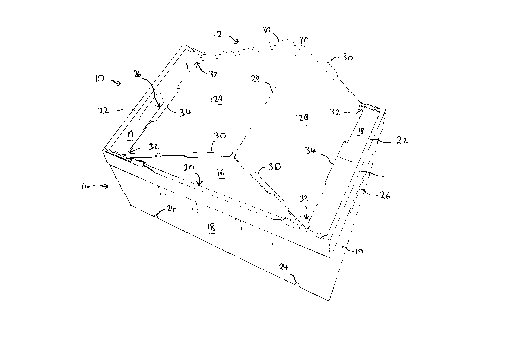Une partie des informations de ce site Web a été fournie par des sources externes. Le gouvernement du Canada n'assume aucune responsabilité concernant la précision, l'actualité ou la fiabilité des informations fournies par les sources externes. Les utilisateurs qui désirent employer cette information devraient consulter directement la source des informations. Le contenu fourni par les sources externes n'est pas assujetti aux exigences sur les langues officielles, la protection des renseignements personnels et l'accessibilité.
L'apparition de différences dans le texte et l'image des Revendications et de l'Abrégé dépend du moment auquel le document est publié. Les textes des Revendications et de l'Abrégé sont affichés :
| (12) Demande de brevet: | (11) CA 2236051 |
|---|---|
| (54) Titre français: | RECIPIENT |
| (54) Titre anglais: | CONTAINER |
| Statut: | Réputée abandonnée et au-delà du délai pour le rétablissement - en attente de la réponse à l’avis de communication rejetée |
| (51) Classification internationale des brevets (CIB): |
|
|---|---|
| (72) Inventeurs : |
|
| (73) Titulaires : |
|
| (71) Demandeurs : |
|
| (74) Agent: | RICHES, MCKENZIE & HERBERT LLP |
| (74) Co-agent: | |
| (45) Délivré: | |
| (22) Date de dépôt: | 1998-04-27 |
| (41) Mise à la disponibilité du public: | 1998-10-29 |
| Licence disponible: | S.O. |
| Cédé au domaine public: | S.O. |
| (25) Langue des documents déposés: | Anglais |
| Traité de coopération en matière de brevets (PCT): | Non |
|---|
| (30) Données de priorité de la demande: | ||||||
|---|---|---|---|---|---|---|
|
Un couvercle de récipient 12 a une partie de sécurité 36 rattachée à une ligne d'articulation 38 de sorte que, lorsque le couvercle est mis en place, la partie 36 peut descendre à l'intérieur du récipient pour obstruer une ouverture dans la paroi du récipient de manière à améliorer la sécurité. Des rebords 44 appuient sur le dessous du couvercle 12B pour empêcher la partie de sécurité 36 d'être écartée de l'ouverture obstruée. Le couvercle est décrit comme faisant partie d'un récipient dont le corps peut s'emboîter dans celui d'un récipient semblable dont le couvercle est enlevé et logé à l'intérieur du récipient quand celui-ci n'est pas utilisé.
A container lid 12 has a security portion 36 attached at a hinge line 38 so
that as the lid is closed, the portion 36 can hang down inside the container to
obstruct an aperture in a wall of the container, thereby improving security.
Flanges 44 abut the underside of the lid 12B to prevent the security portion 36
being pushed away from the aperture being obstructed. The lid is described as
part of a container whose body can nest with a body of a like container, with the
lid removed and housed within the container, when not in use.
Note : Les revendications sont présentées dans la langue officielle dans laquelle elles ont été soumises.
Note : Les descriptions sont présentées dans la langue officielle dans laquelle elles ont été soumises.

2024-08-01 : Dans le cadre de la transition vers les Brevets de nouvelle génération (BNG), la base de données sur les brevets canadiens (BDBC) contient désormais un Historique d'événement plus détaillé, qui reproduit le Journal des événements de notre nouvelle solution interne.
Veuillez noter que les événements débutant par « Inactive : » se réfèrent à des événements qui ne sont plus utilisés dans notre nouvelle solution interne.
Pour une meilleure compréhension de l'état de la demande ou brevet qui figure sur cette page, la rubrique Mise en garde , et les descriptions de Brevet , Historique d'événement , Taxes périodiques et Historique des paiements devraient être consultées.
| Description | Date |
|---|---|
| Inactive : CIB de MCD | 2006-03-12 |
| Inactive : CIB de MCD | 2006-03-12 |
| Inactive : CIB de MCD | 2006-03-12 |
| Demande non rétablie avant l'échéance | 2002-04-29 |
| Le délai pour l'annulation est expiré | 2002-04-29 |
| Réputée abandonnée - omission de répondre à un avis sur les taxes pour le maintien en état | 2001-04-27 |
| Demande publiée (accessible au public) | 1998-10-29 |
| Modification reçue - modification volontaire | 1998-09-04 |
| Inactive : Transfert individuel | 1998-09-04 |
| Symbole de classement modifié | 1998-08-11 |
| Inactive : CIB en 1re position | 1998-08-11 |
| Inactive : CIB attribuée | 1998-08-11 |
| Inactive : Lettre de courtoisie - Preuve | 1998-07-14 |
| Exigences de dépôt - jugé conforme | 1998-07-09 |
| Inactive : Certificat de dépôt - Sans RE (Anglais) | 1998-07-09 |
| Demande reçue - nationale ordinaire | 1998-07-08 |
| Date d'abandonnement | Raison | Date de rétablissement |
|---|---|---|
| 2001-04-27 |
Le dernier paiement a été reçu le 2000-03-28
Avis : Si le paiement en totalité n'a pas été reçu au plus tard à la date indiquée, une taxe supplémentaire peut être imposée, soit une des taxes suivantes :
Veuillez vous référer à la page web des taxes sur les brevets de l'OPIC pour voir tous les montants actuels des taxes.
| Type de taxes | Anniversaire | Échéance | Date payée |
|---|---|---|---|
| Enregistrement d'un document | 1998-04-27 | ||
| Taxe pour le dépôt - générale | 1998-04-27 | ||
| TM (demande, 2e anniv.) - générale | 02 | 2000-04-27 | 2000-03-28 |
Les titulaires actuels et antérieures au dossier sont affichés en ordre alphabétique.
| Titulaires actuels au dossier |
|---|
| MCKECHNIE UK LIMITED |
| Titulaires antérieures au dossier |
|---|
| ANDREW CHRISTOPHER COPE |